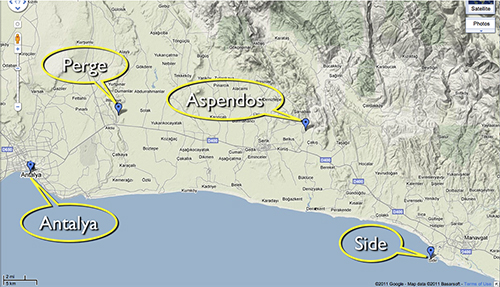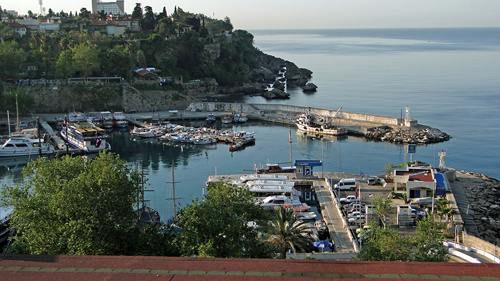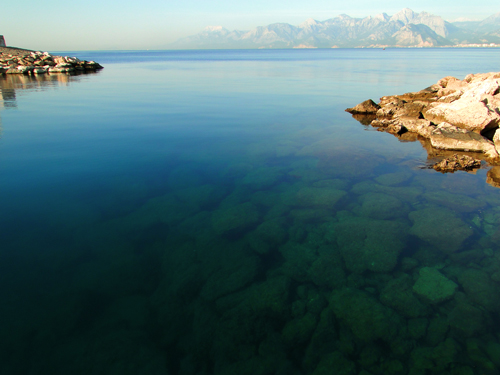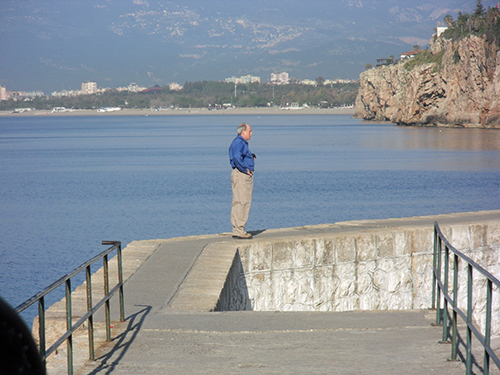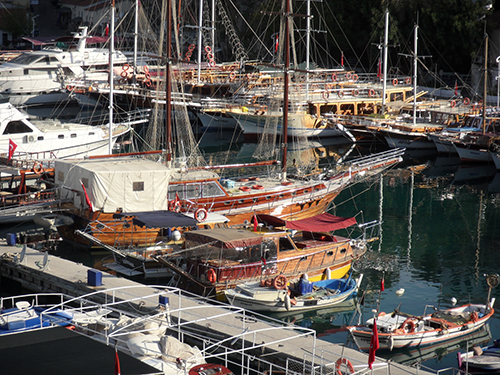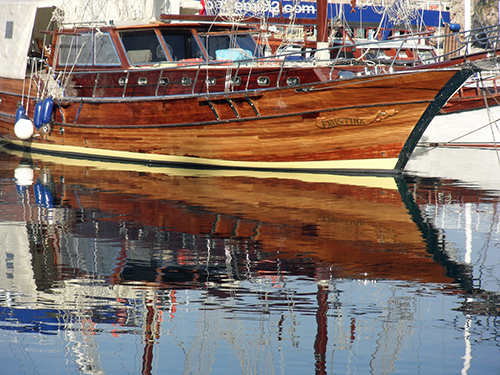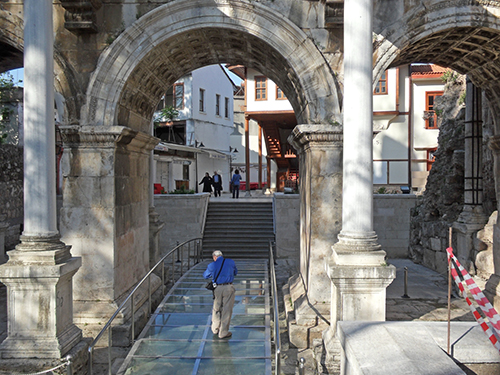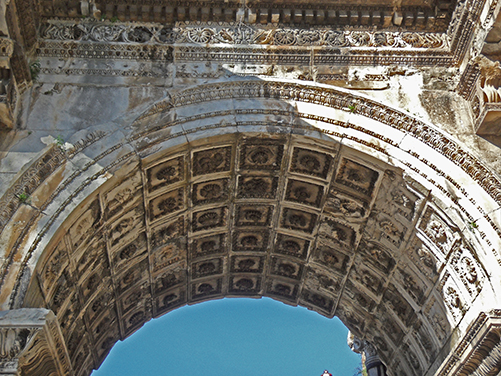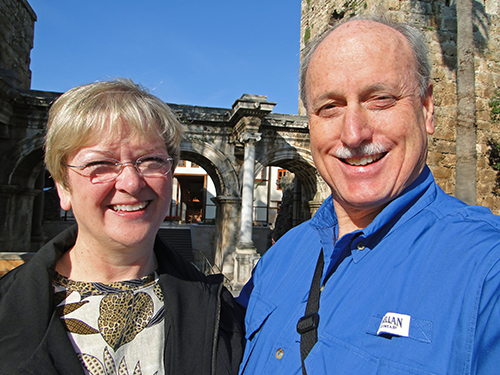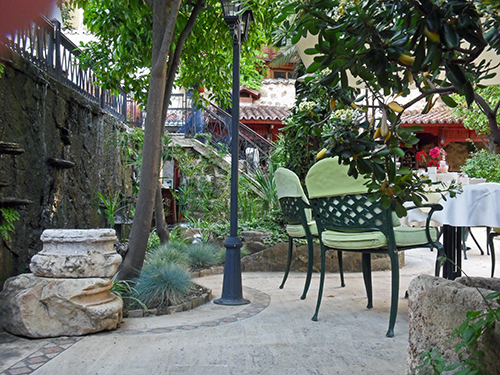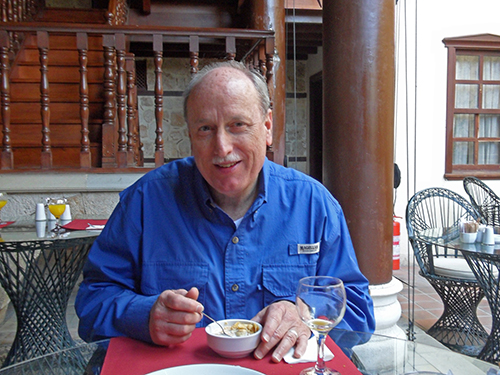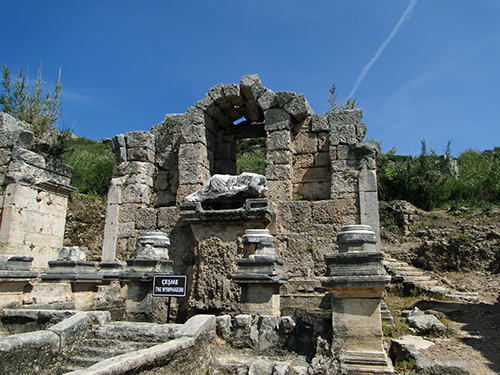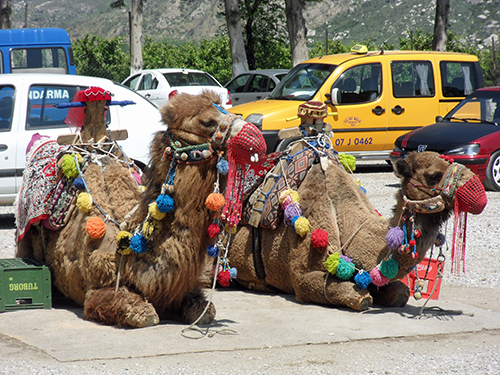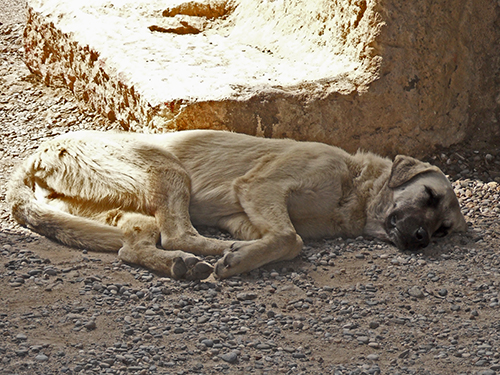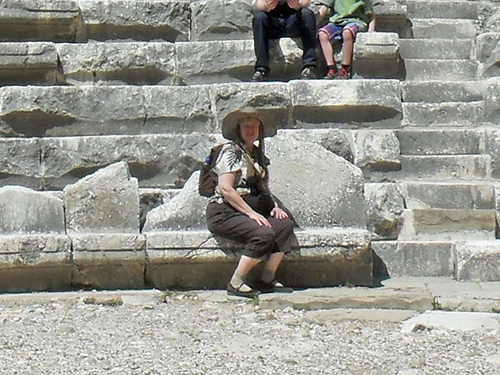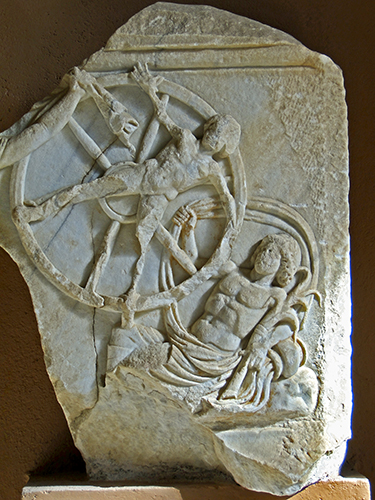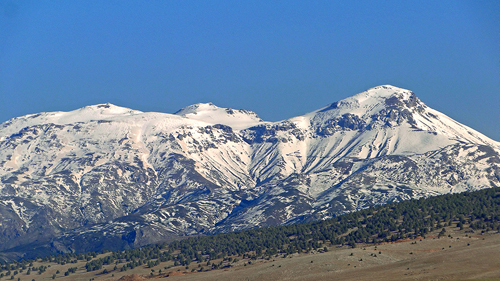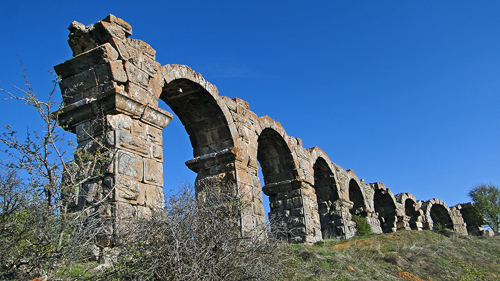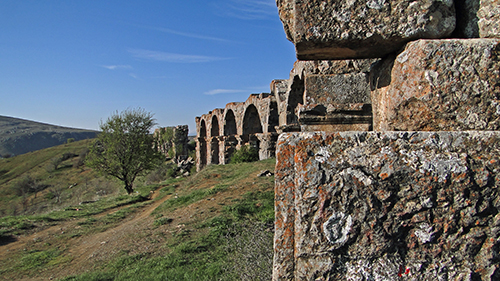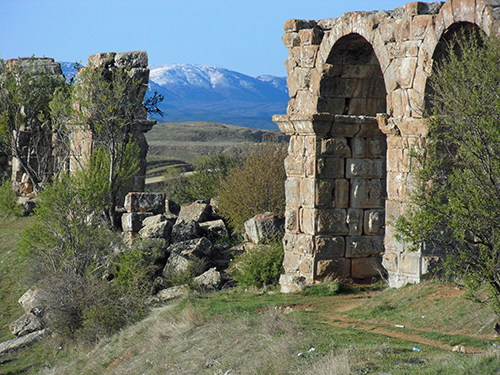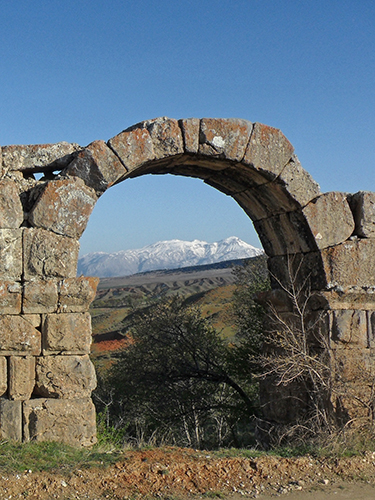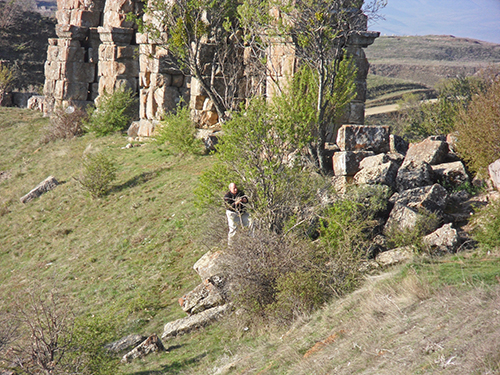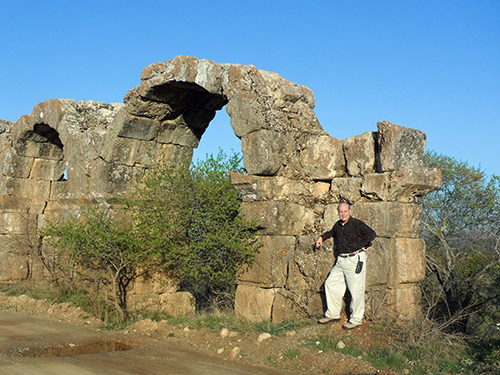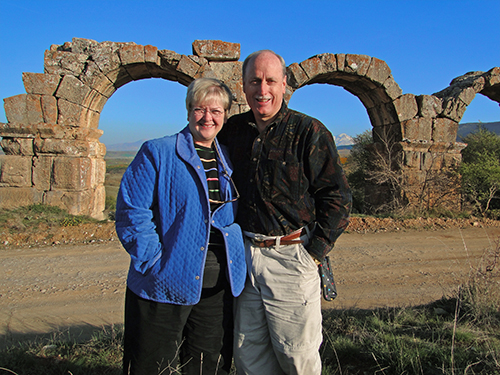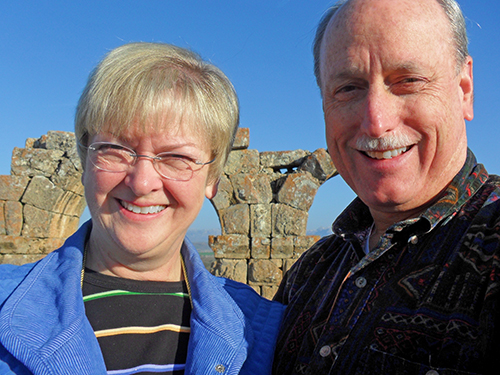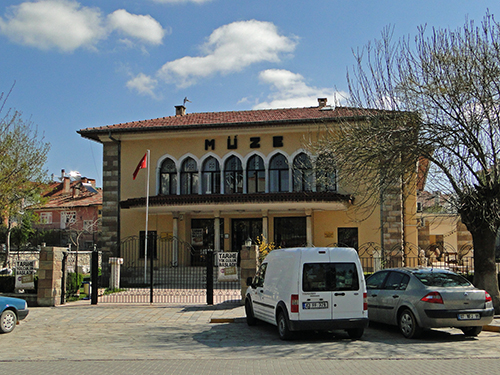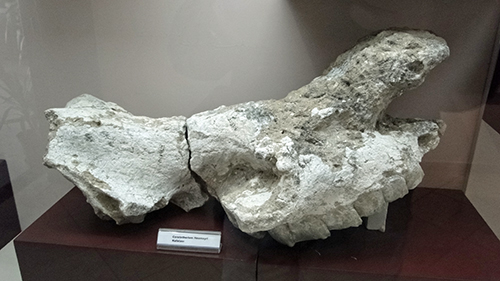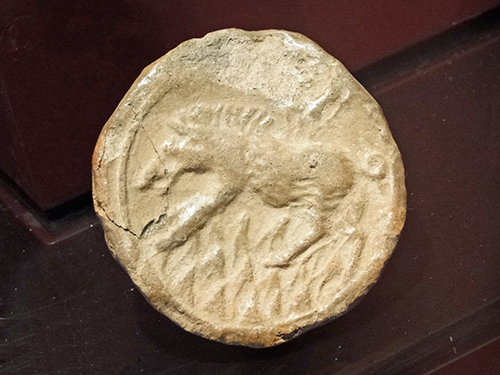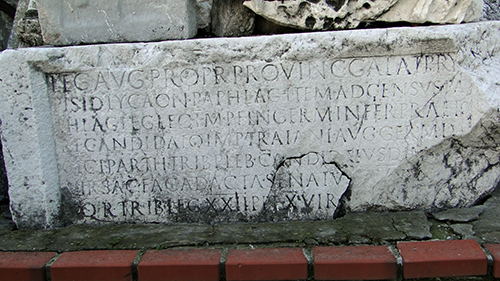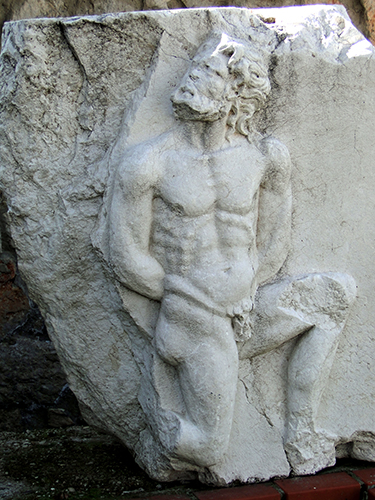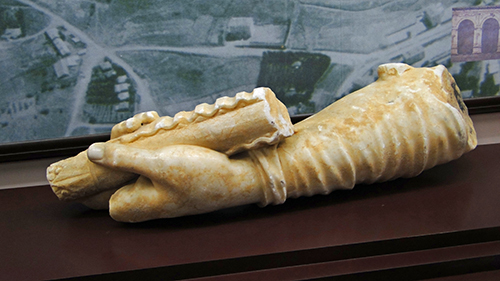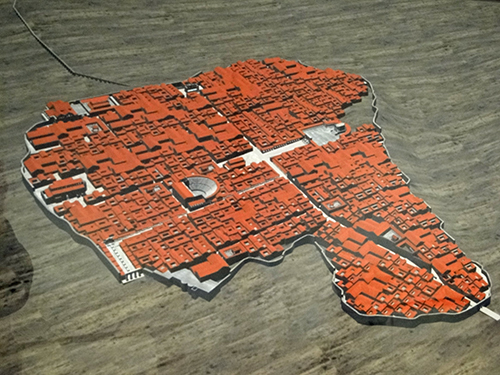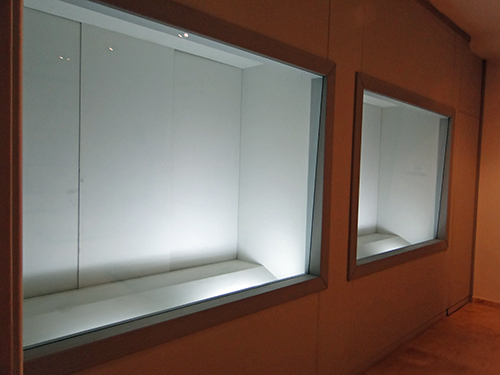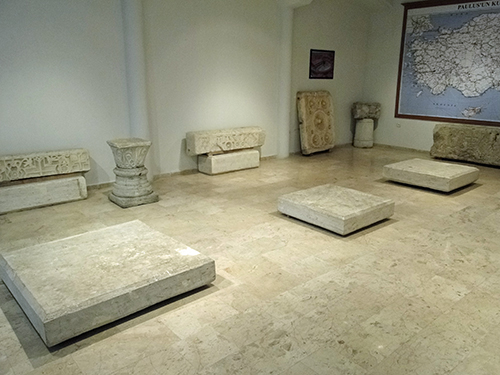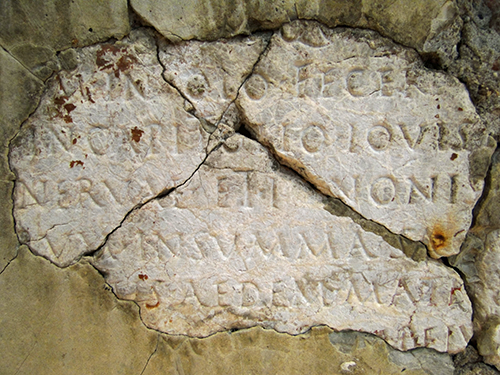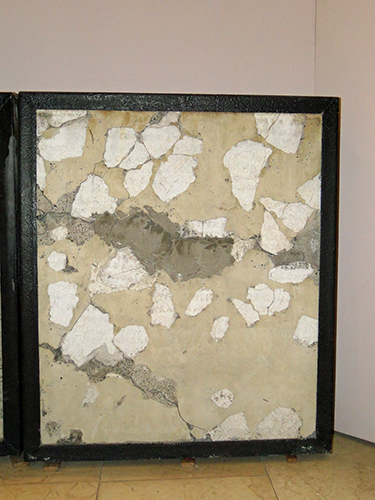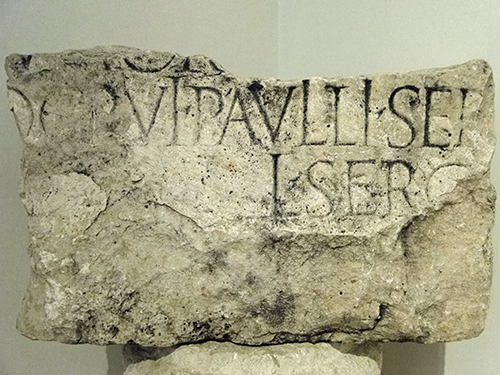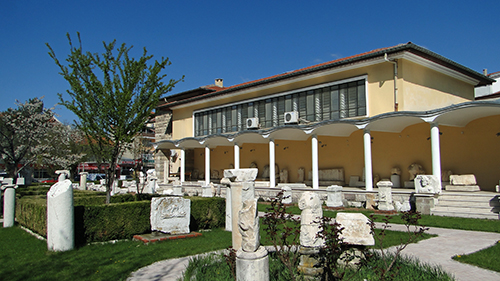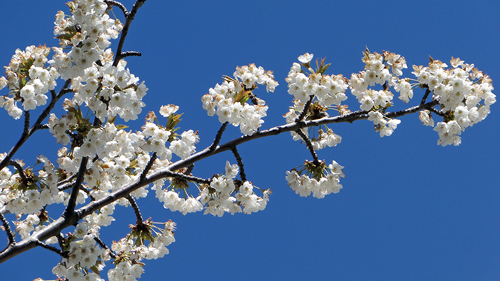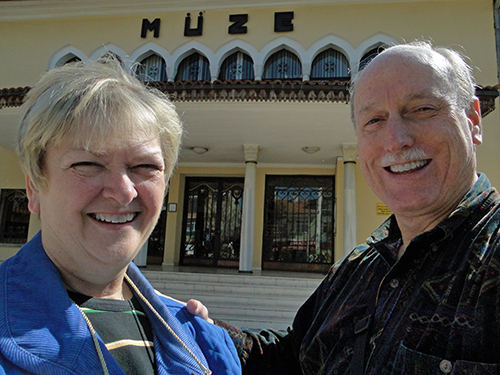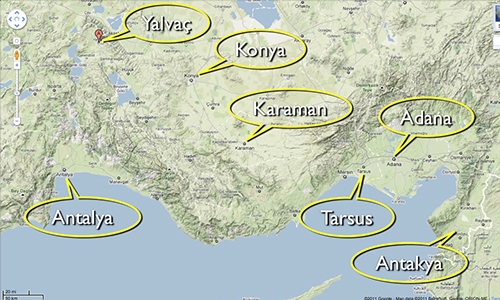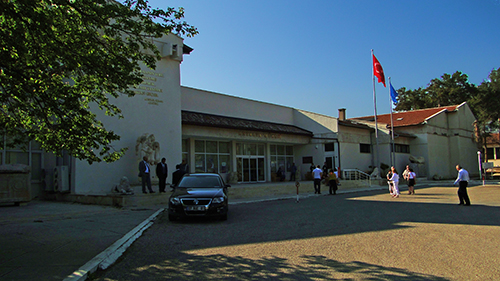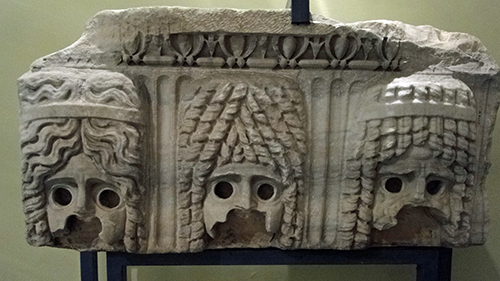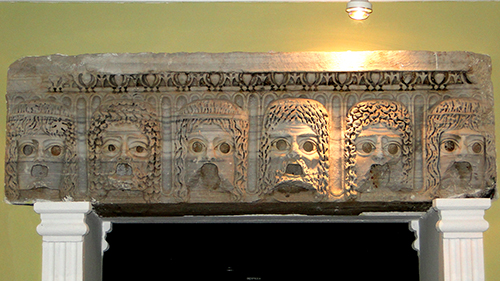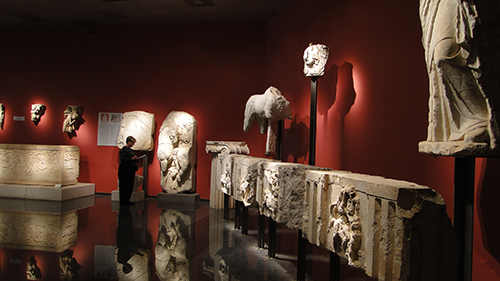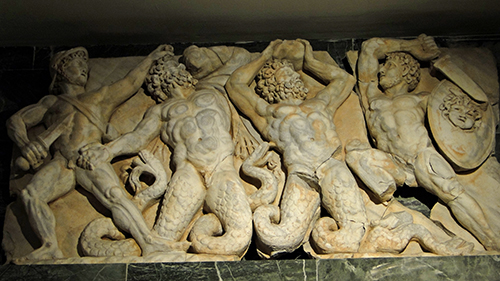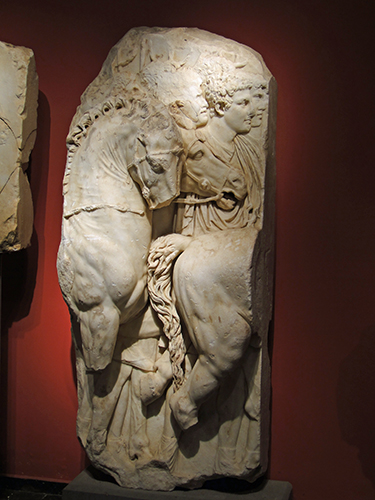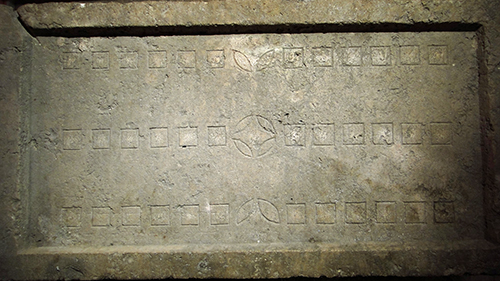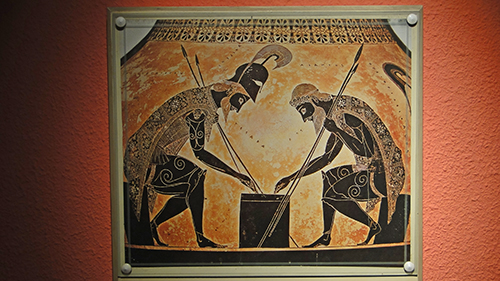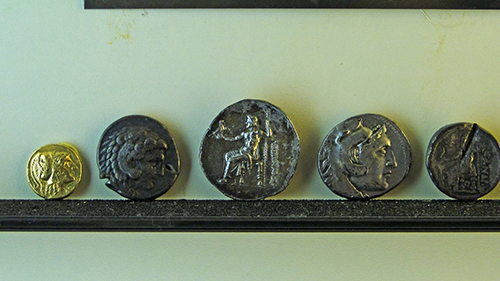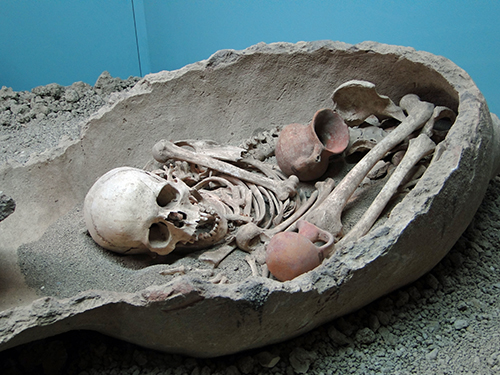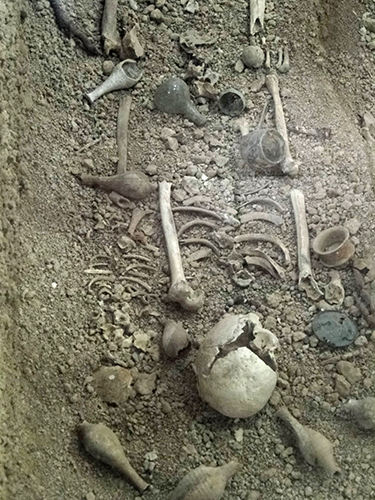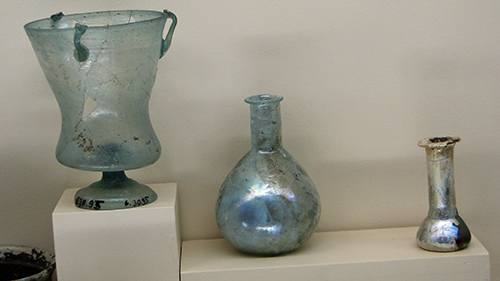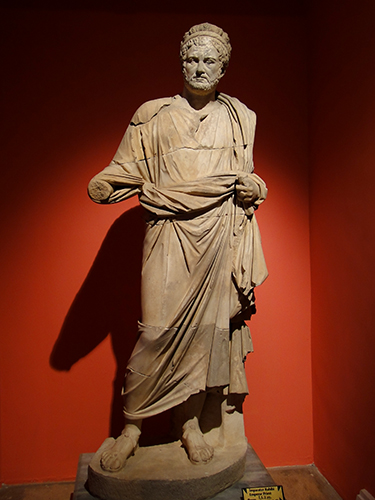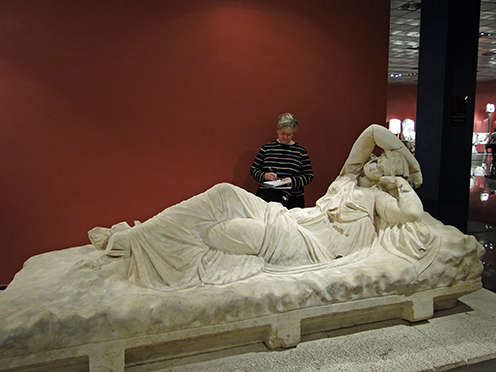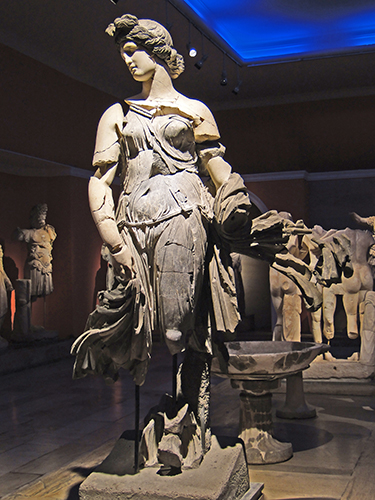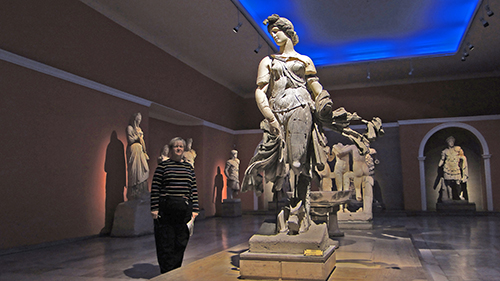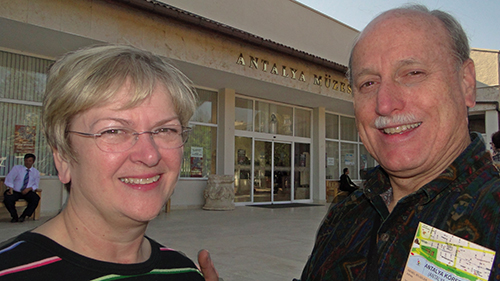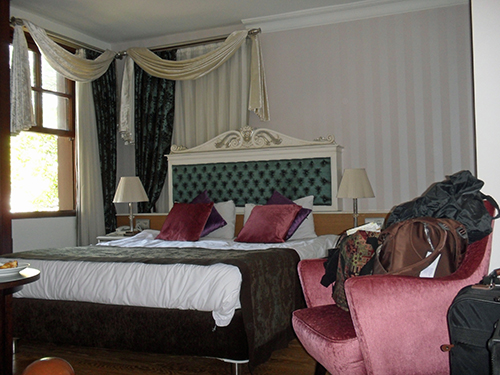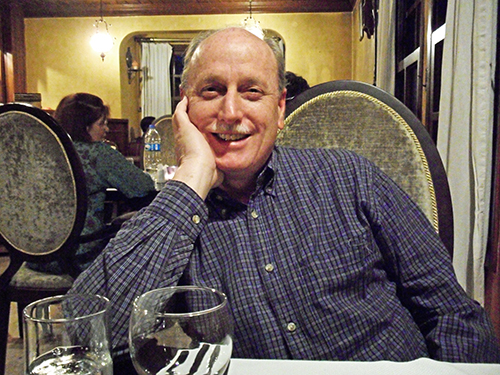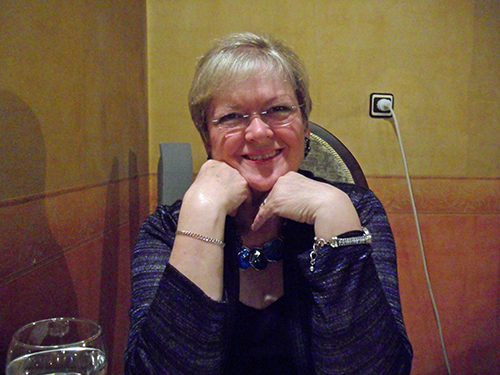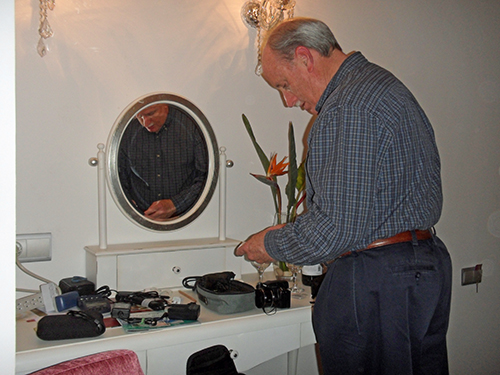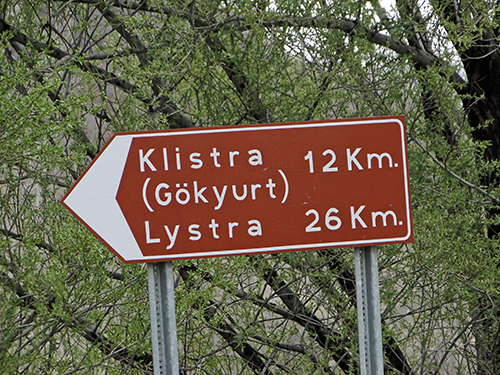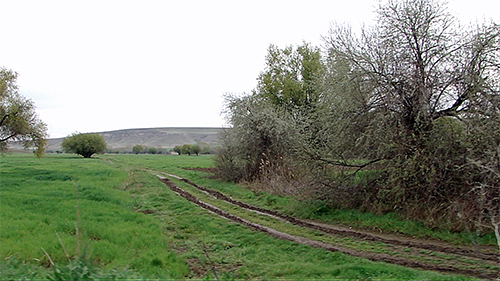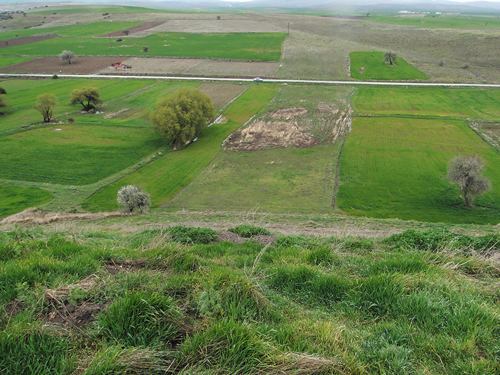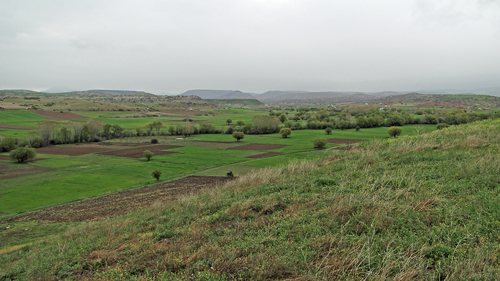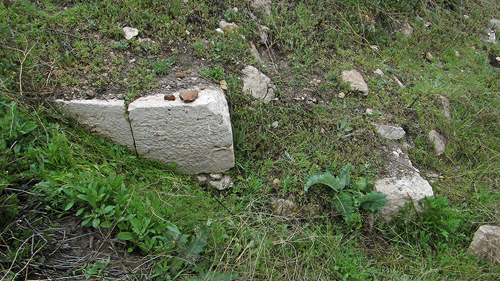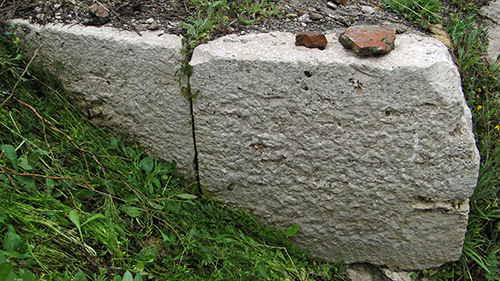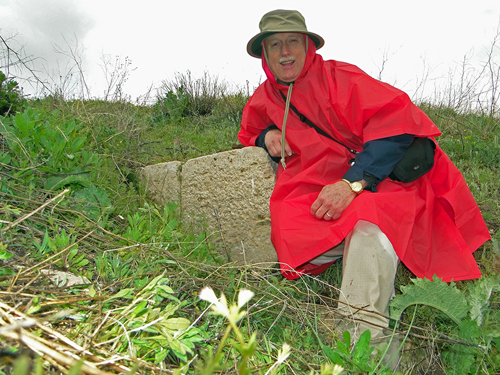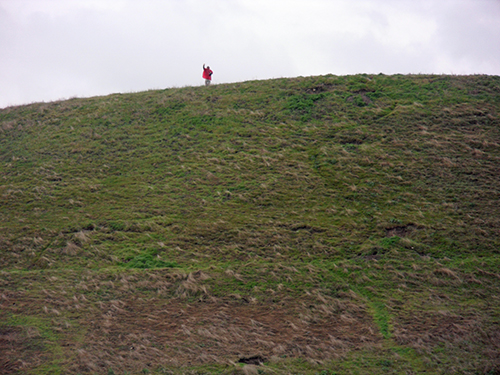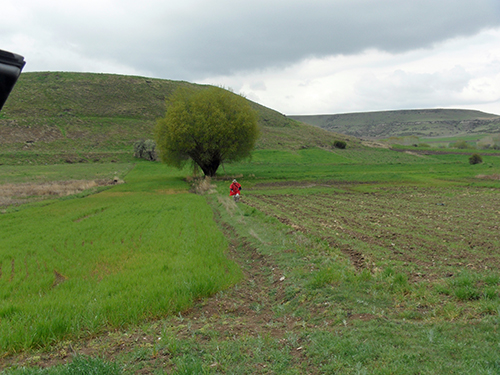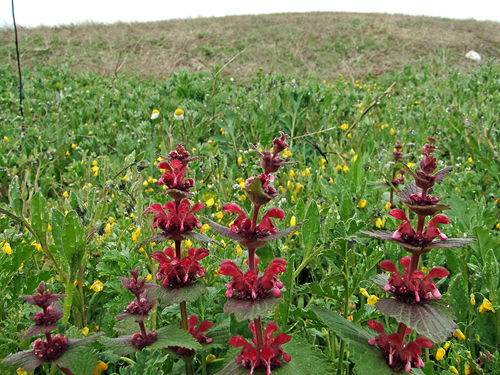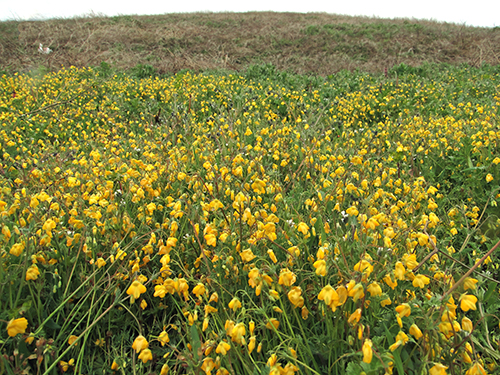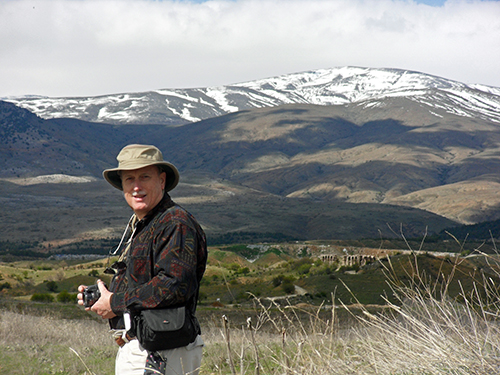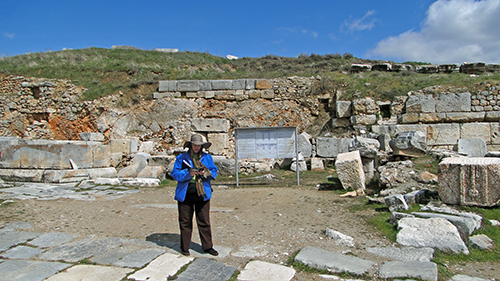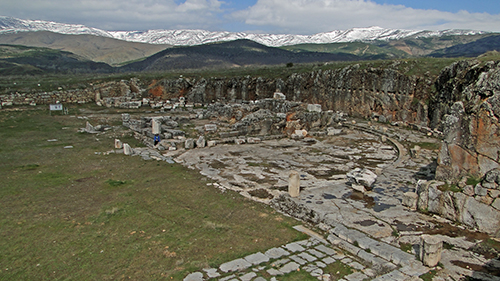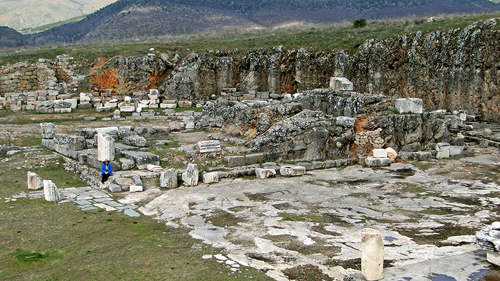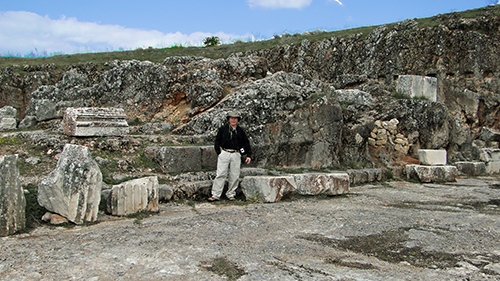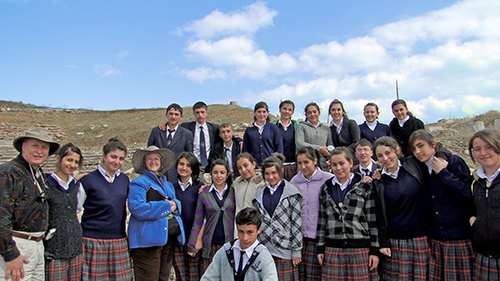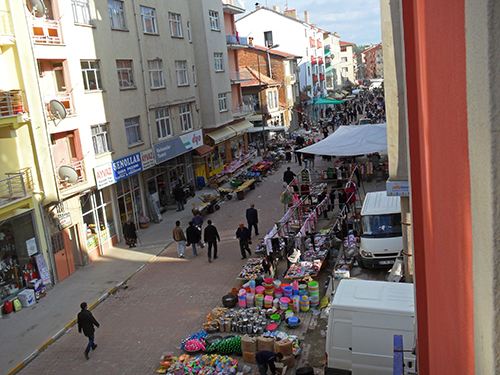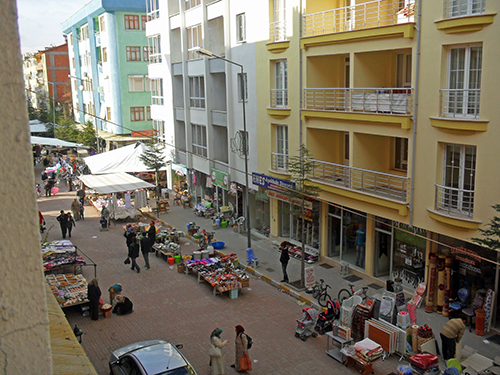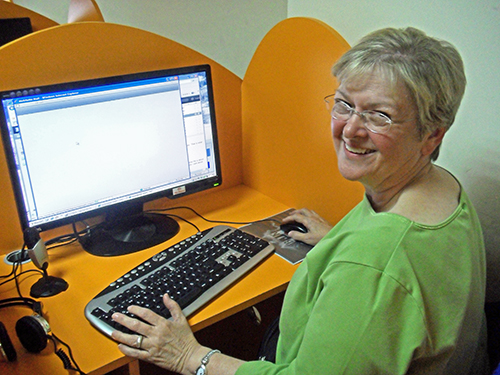April 14, 2010 (Wednesday)
Antalya Harbor. We got up early. Jerry is still tired from the harrowing day yesterday in the long, hard drive through the mountains down to the southern coast of Turkey and then damaging the rental car bumper in the Antalya Museum parking lot. When we ask this morning, we find out our Tuvana Hotel breakfast is not served until 8 am, so unexpectedly we have time to do something before breakfast. We decide to take in the old harbor from which Paul and Barnabas sailed, whose ancient name is Attalia. We ask for directions, and head out walking in that direction. The walk is easy, and the morning is beautiful.
The foothills of the mountains run right up to the shoreline, and reminds us a little of California’s Pacific coastline. We are up in elevation and are descending to the harbor. From this higher elevation on this cool, crisp morning, the harbor lays like a gemstone glistening. The view is picture postcard. The boats are colorful. The water is perfectly clear. When we get to the water’s edge, the harbor is so clear and calm like glass, you can see down some 30 or 40 feet, or more. We do a “talking head” movie of Jerry at the harbor that is great! We spend some time at this harbor where Barnabas and Paul caught a boat at the end of the first missionary journey on their way back to Antioch of Syria. I get to thinking that what Paul accomplished in his missionary travels is amazing. The distance from Antioch of Pisidia in the highlands of the mountains down to Antalya on the Mediterranean coast is quite far, so I’m wondering how long Paul took to walk that distance. I must do some research into Roman roads and distances traveled.



Hadrian’s Gate. We leave the harbor and start walking back towards the hotel through the streets of old Attalia. As if he had radar implanted, Jerry walked not to our hotel but straight to Hadrian’s Gate! (We had planned to do that after breakfast, but here we are.) The gate is beautiful in the morning sun and is important to my intrepid scholar as the only surviving Roman remains of ancient Attalia. He was especially pleased that the original Roman paving stones through the gate were preserved for viewing with a see-through walkway over them.
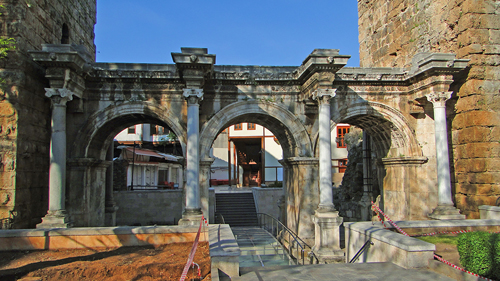
We finish picture taking and walk back to the hotel, asking directions now and then from shopkeepers along the way. The winding streets of Old Town Attalia are confusing. One man we asked for directions wanted to have a conversation so he could practice his “English.” He was very nice, offering us tea, as is the Turkish custom. We shared tea and conversation and enjoyed his hospitality.
We said a courteous goodbye to our friendly shopkeeper and moved on to our breakfast at Tuvana hotel. (The nose-blowing lady from dinner last night is here—ugh!) Once breakfast is done, we are off to check out of our delightful hotel, sad that we could stay only one night, and get the car.
Paul Harvey. This part of the journal is like the old Paul Harvey reports on the radio. Paul Harvey would set up a story in the opening bit, and, after a commercial break, he always would finish his story by starting with the line, “And, now, the rest of the story.”
So, here’s the opening Paul Harvey bit. We get directions from the car attendant how to get out of town and head to the ancient site of Perge, another stop of Paul on the first missionary journey, which is not far at all inland from the ancient port of Attalia. Well, of course, after we leave the hotel parking area, we find out that the way we are told to go is blocked by road construction right in the middle of busy downtown—naturally! To backtrack, Jerry has to make an impossibly tight right turn. Sure enough, trying to negotiate the turn with the sharp angle of the car and avoiding pedestrian traffic on the sidewalk was too difficult in the tight space, and Jerry scrapes the car’s right side on the high curb—dang those Antalya curbs! That’s the second time in less than 24 hours we have sustained damage to our rental car in Antalya due to high curb structures. With all the traffic now tied up behind us, we have no choice but to back up, get straightened out, and take a second shot at the tight turn, which Jerry somehow manages this time. We continue on our way with our damaged car. We find the main highway of D400 toward Perge, and off we go, although we are so disgusted, upset, and worried about the car.
“And, now, the rest of the story . . .” Is the Antalya story over yet? Well, no, not quite. Wait! There’s more! So, we’re tooling down the road moving along evenly with everyone else, and then suddenly a Polis officer is waving us over! We got a speeding ticket! 97.50 Turkish lira! We were flowing evenly with all the other traffic, not even passing anyone—yet, we are the ones pulled over! Jerry was so mad. Now, we’re beginning to think something is going on. In less than 24 hours we have damaged the rental car, not once, but twice, and then added a speeding ticket on top of that! Thank heavens we had stopped at that ATM. We pay the officer, get a receipt, and off we go. Jerry is steaming. He was not even trying to speed. This is turning into a very disgusting morning.
Perge. We easily find the signs on D400 to the ancient site of Perge and head there. Perge is where John Mark left the mission team on the first missionary journey after the initial work on the island of Cyprus, which upset Paul greatly. The issue of John Mark even fractured the mission team at the beginning of the second missionary journey, when Paul and Barnabas argued so strongly over John Mark’s participation that they parted company.
Once we arrive at Perge, which does not take long, we find the site is good. The central triple-arch gate into the city is still preserved. The nymphaeum (water fountain or water supply) is a beautiful, elaborate edifice, and the water ran down into a canal system in the middle of the street that flowed for several hundred yards. (I guess New Orleans is not the only city that at one time had a canal down its main avenue.) Perge has a very well preserved stadium. [A stadium is not the same as a theater; a stadium is an oblong oval used for footraces in the Greek world and later for chariot races in the Roman world.—Jerry] The theater officially is “closed,” but Jerry found a way to get some pictures anyway by climbing up a steep incline on the backside through thistles and briars. When he is “on the hunt” for a picture, that boy hardly can be denied, I must say. Jerry was excited to discover some nifty information in an inscription on the Perge site about a Roman lady who was a powerful patron of the city and held important civic offices. He said this inscription was important for sociological documentation.
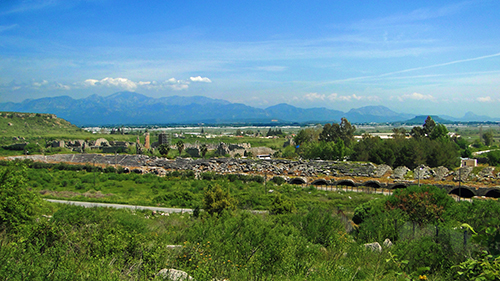

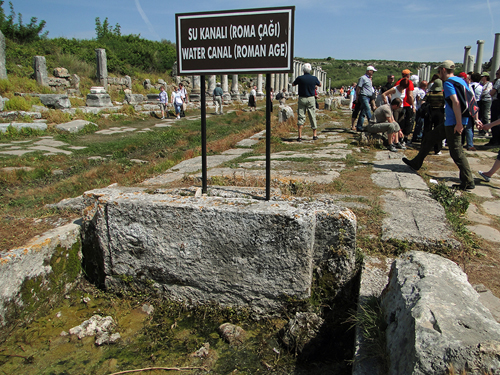
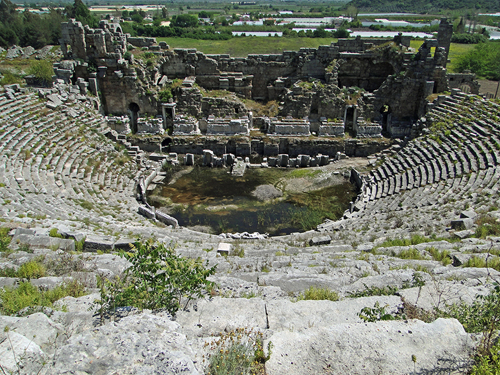
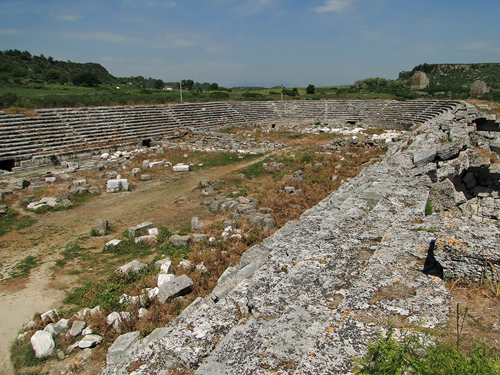
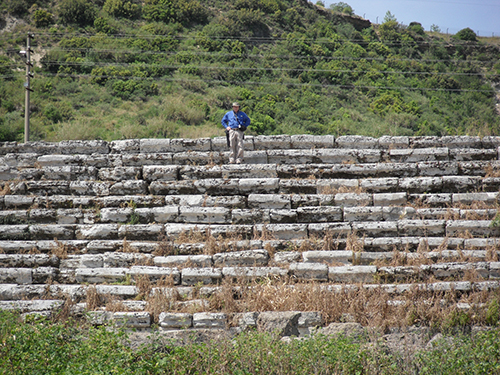
Aspendos. When we finish the site of Perge, we think we still have time to take in another ancient site nearby called Aspendos, which has a magnificent theater, so we head there.
Really, that’s all to see there—the theater, but what a theater! Really stupendous. Stupendous Aspendos. (Is there an echo in here?) The theater is simply the best-preserved theater in Asia Minor from the ancient world. I liked the colorful camels in the parking lot, but Jerry said we were not riding. You should note that the Aspendos theater has a ferocious guard dog, but we managed to avoid his vigilant sentinel. Jerry talked me into climbing all the way to the top of the theater—and what a view! Well worth the climb and vertigo.
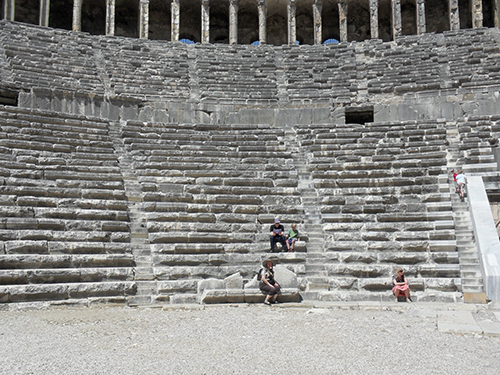
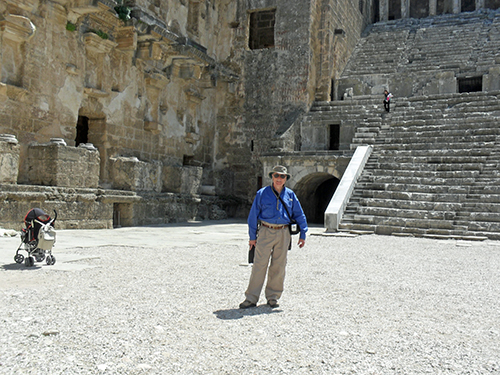
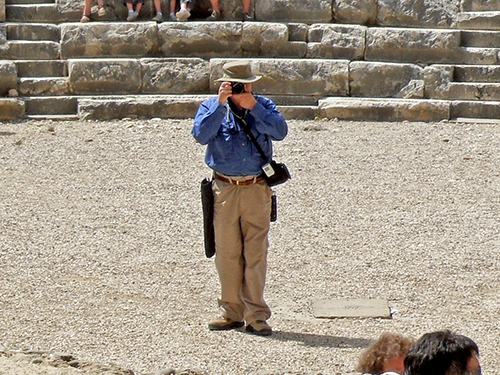
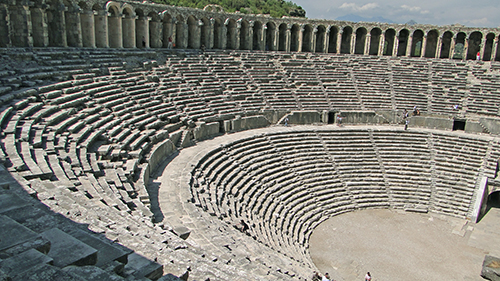
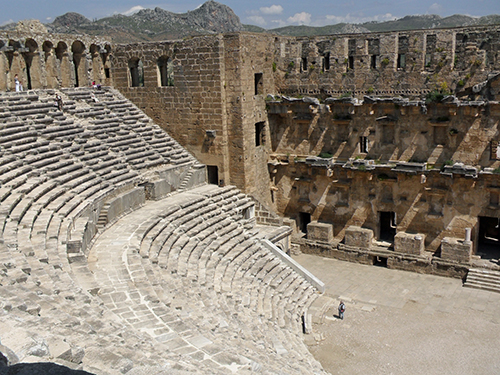
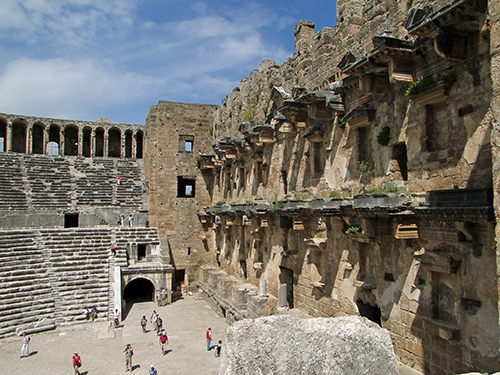
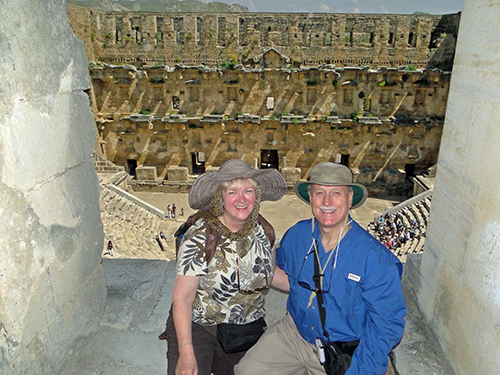

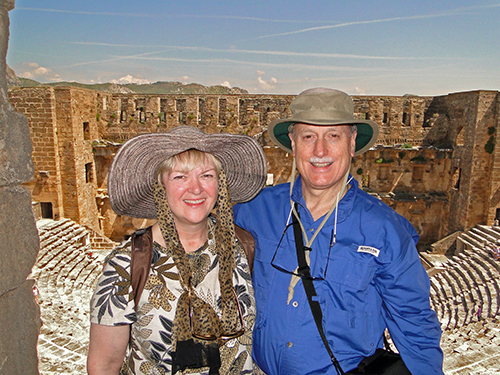
Side. Once finished at Aspendos, we head on down D400 to the resort town of Side, where we’ll have some down time for a few days. We get to Side, and the Garmin does help us get to the general area of the hotel we have reserved. However, when we finally find the hotel, the sight is dismal. [In Jean’s defense, we were being helped by a different travel agent for these arrangements, and that did not work well for this location.—Jerry] The place looks completely deserted, and paint is peeling off the walls badly. Yuck! We locate and talk to the proprietor but don’t get our luggage out. We decided to go to the ancient site of Side not far from the modern town, which is right on the shoreline, to try to see the theater and the archeological museum before closing time, but also to try to find a different hotel, even though we’ve already paid for this one.
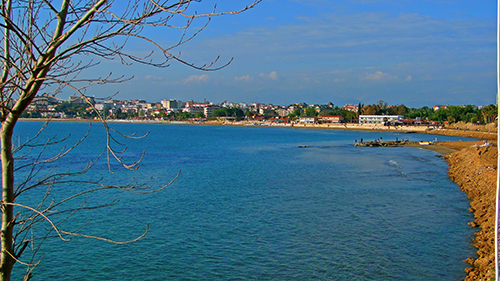
Side Museum. We find the museum right next to the entrance road leading up to the archeological sight and ancient theater. We do the museum in a rush, because closing time is closing in quickly. Since the museum is small, we fortunately are able to canvas the holdings in our small window of time.
We view displays of nice coins that, unfortunately, are not dated or described, figurines, and Roman glassware. The influence of the sea on the city’s life is seen in exhibits of wine amphores and boat anchors. (This is the only museum we have seen, including in Europe, that has a display of ancient boat anchors.) We are discovering that every museum, even a small one, seems to offer something distinctive. Jerry finds another notable item of this museum in its interesting display of Roman burial practices and artifacts. Also, we saw a rare relief depicting the punishment of Ixon, a Greek myth not well known. [Xion treacherously killed his father-in-law, the first act of kin-slaying in Greek mythology. Stigmatized by all, Xion received Zeus’s mercy and was taken to Mount Olympus. There, however, Xion lusted for Hera, Zeus’s wife, and was punished forever bound to a winged, rotating fiery solar wheel.—Jerry] Some sarcophagi were on exhibit, but a notable one was a really fine example, well preserved, of the Pamphylia type from the 2nd century A. D. that had the typical Eros and Nike reliefs. The museum’s outer courtyard had more Roman sun dials on display than we have seen anywhere. A gladiator stele demonstrated how this particularly Roman bloodsport was ubiquitous throughout the Roman empire. We barely are able to finish the museum just as they lock the entrance gate behind us.
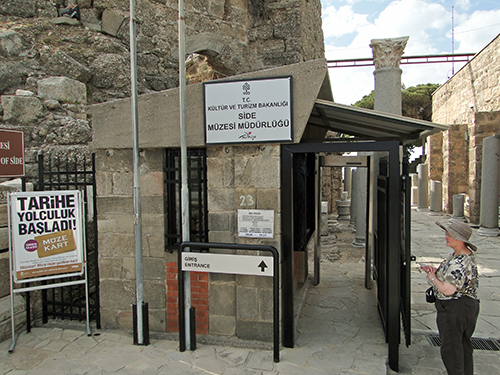
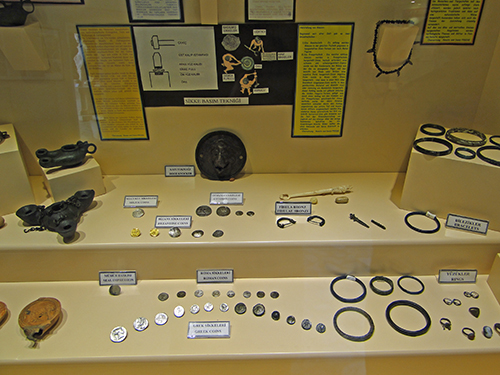
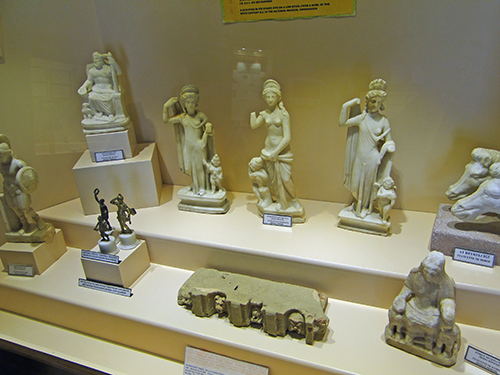
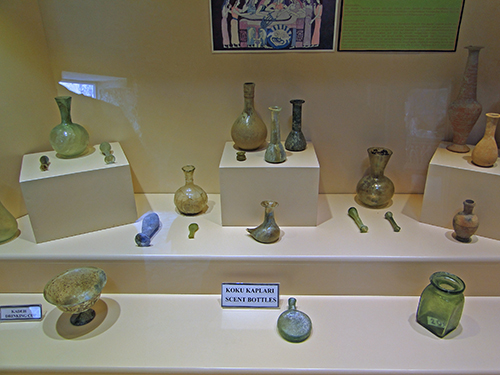
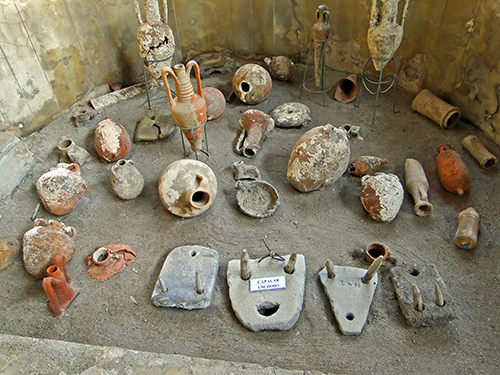
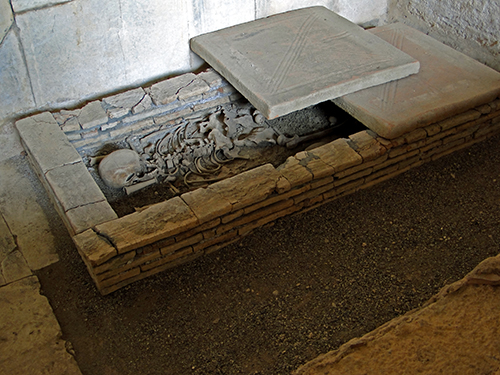
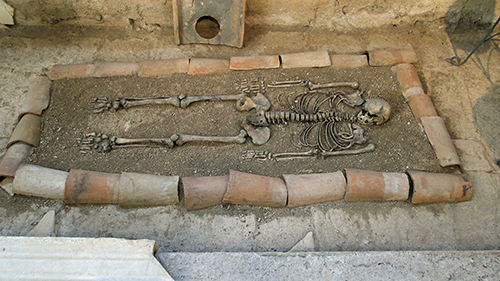
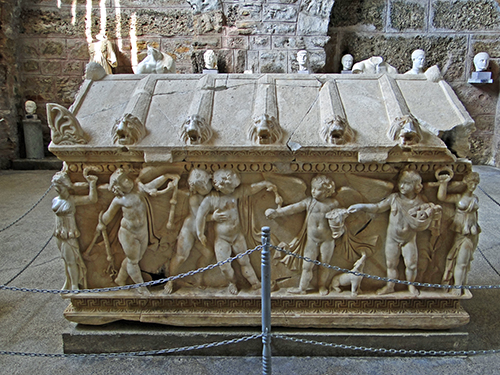
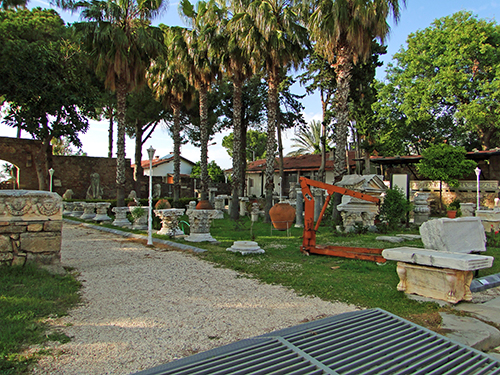


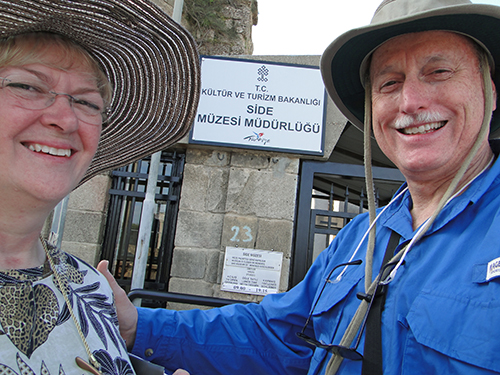
Site Visit. We ride around the Side site to see what we can see. We walk around the outside of the outer wall of the theater (but cannot go in due to being closed). From the backside of the upper elevation of the theater, Jerry gets a few shots overviewing the general site from a high point looking down over the general agora (market area) and forum.
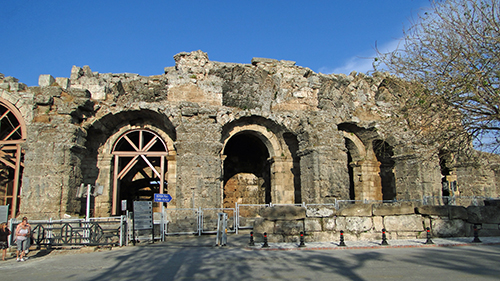

Vespasian Monument. Leaving the parking area for the Side site going down the hill toward the city wall one catches a view of a distinct architectural piece integrated into the outer wall of the city. The inscription shows that the monument originally was dedicated to Emperor Vespasian (A.D. 69–79) and was meant to be a double-stepped podium for speaking purposes flanked by two Aediculae sides and a center niche, probably for a statue. Over time the podium and honorarium to Vespasian lost its function and was moved to its present location, where the monument was converted into a fountain. Jerry found this Side connection to Vespasian meaningful, since Vespasian was the Roman general who conducted the Jewish War (A.D. 66–70), leaving his son Titus to finish the siege of Jerusalem and destruction of the Jewish temple when Vespasion went to Rome to acclaim himself emperor to end the Roman Civil War that ensued after Nero’s suicide. Vespasian also conceived and initiated the building of the Colosseum, the most well-known Roman edifice in the world, which was finished and dedicated by Titus (c. A.D. 80). Many do not realize that Jewish slaves from the Jewish War and spoils of the Jewish temple treasures helped build and finance Vespasian’s Colosseum project (so Josephus).
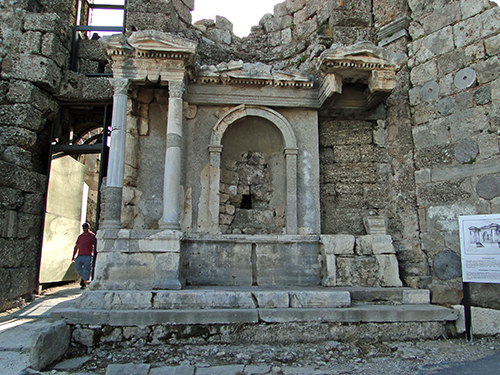
Hotel Hunting. We still have a little daylight left, so we ride back into town and try to find another hotel. Unfortunately, we are finding out what being early birds before the tourist season officially opens means—nothing much is open. The entire town is vacated like a hurricane exodus along the Gulf coast. Hotels are closed. Stores are closed. We have no options. We were going to use our Side stop for a little well-deserved R&R (we have been going non-stop dawn to dusk for fourteen days straight) at what we thought was a resort area. We learn too late that Side is a “resort area” only some months of the year. We become proactive about our predicament and decide to cut short our stay in Side to just one night, preferring to push hard the next day in a long drive to get all the way to the Pamukkale area tomorrow. Since we stayed in Pamukkale the last time we were in Turkey in 2002, we know Pamukkale is a beautiful resort area open year round.
However, first we need to eat after a long day, so we hit the main drag. Once again, we are confronted by the realities of a non-resort resort area. Most restaurants in town are closed too, since it’s “early for the season.” Only a few restaurants are open. We finally find a very small café that is open that we feel like trying and catch a little supper. We are, of course, the only customers. The lady who is the proprietor cooks eggplant with red sauce, soup, and bread, which is actually very tasty.
After touring and supper, we finally get back to the hotel and see the proprietor. We tell him we’ll cut our stay short and leave tomorrow. I was proud of Jerry, because he managed this communication feat without insulting our host. Those pastoral skills sure do come in handy.
Paul Harvey Redux. So here we are in this horrible little room. The “shower” is just a spigot in the wall of the bathroom with no shower curtain, so getting a shower and not getting the rest of the tiny room wet is very difficult. Amazingly, the hotel does have wifi, so I get Skype to work, which facilitates making long-distance phone calls. After reading and interpreting the “legaleze” of the car rental documents, I decide we have to report the “damage” the car has sustained within 24 hours. I was soon to discover, fat chance.
“And now, the rest of the story.” I place the long-distance call to the number indicated on our papers. Unfortunately, the conversation is extremely frustrating. The person who answers has incredibly poor English. She keeps telling me over and over that I have to “get a Polis report.” She seems not to understand the nature of the “damage,” that is, that what happened was not an “accident” that involved another vehicle or the Polis coming, or any official report being written up. I finally gave up the communication struggle locally. I decide that I’ll try to call Avis in the USA. The Avis representative advises me to call the place where we rented the car, which was way back in Adana. I try and try to reach the car rental place in Adana but cannot. I’ll have to try to call them the next time I have Skype.
To bed with only a very thin sheet. Even though the walk down to the old Attalia harbor this morning was really nice, and the ancient sites of Perge, Aspendos, and Side were useful, productive visits for Jerry, on the whole, with the damage to the rental car, a completely undeserved speeding ticket not minutes later, a true dump of a “hotel” this afternoon, and an impossible communication struggle just trying to do the right thing tonight, today has been a really bad day. Probably the worst. We are tired from our travel, anxious about the car, miffed over a ticket, and lying in a dump.
For a video of the Antalya, Perge, Aspendos and Side action today:
